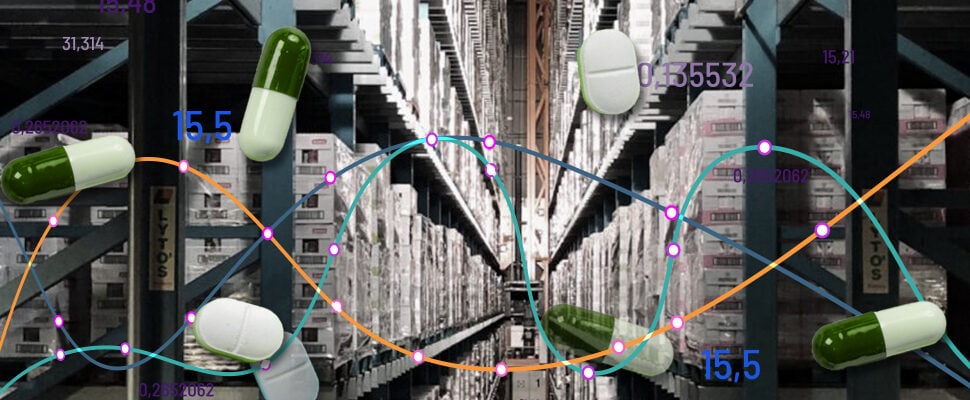Several macro-trends affected the pharmaceutical industry in 2022, impacting its inventory position, writes Matthew Bardell, managing director of specialist inventory consultants nVentic. Bardell highlights findings in a recent report – including the fact that despite widely-reported medicine shortages, Big Pharma’s inventories grew significantly last year – and calls for a more optimised approach to inventory management to improve sustainability efforts, reduce waste, and cut costs.
Lower than expected demand for vaccines and antivirals related to COVID-19 resulted in write-offs of excess inventory. The lingering effects of lockdowns on people’s immune systems saw an increase in demand for several basic medicines which, exacerbated by stockpiling, led to widespread shortages.
An analysis of this year’s reports from 28 pharmaceutical manufacturers led to some interesting findings on Big Pharma inventory trends.
Report Findings
Despite widely reported medicine shortages, major pharmaceutical manufacturers’ inventories grew. In 2022, inventories increased by ten percent year-on-year, reaching a combined total of USD 150 billion.
Ongoing supply concerns caused by factors such as the pandemic, the war in Ukraine, and trade disputes, led firms to deliberately increase their inventories in some cases. 20 of the 28 companies featured in the report saw an increase in Days Inventory Outstanding (DIO) in 2022, with a mean DIO increase of five percent.
However, this overall increase in inventories did not prevent widely reported medicine shortages. Medicine supply chains are long and frequently inflexible and having too much of the wrong inventory does not help.
Inventory Waste
While no standardised reporting framework for inventory write offs exists, estimates from financial reports indicate that approximately four percent of inventory is written off each year by the manufacturers themselves, amounting to a staggering USD 12.5 billion in 2022 across the 28 benchmarked companies. While some waste is unavoidable, this figure represents a significant waste of capacity and resources within Big Pharma. Until more attention is given to this topic across the industry, this excessive waste will continue to be an issue.
Big Pharma Inventories: Why so Big?
Several structural challenges exist within the pharmaceutical supply chain, and it is frequently difficult to respond quickly to sudden changes in demand. Many medicines are critical to life or wellbeing and manufacturers rightly strive to prevent stock outs to avoid unnecessary patient suffering. The regulatory regime, which gives manufacturers only 20 years of patent protection to develop, test and market a medicine, also puts great pressure on maximising sales. All of these factors lead to high inventories compared to many other industries.
However, while Big Pharma has a number of particular challenges when it comes to assuring supply of medicines without creating excess and obsolescence in inventories, it is also true that this has not been treated as a priority in what remains a high-margin industry and that inventories overall seem to increase every year from what is already a high base.
At a macro-level, you would expect there to be some kind of correlation between high inventories and low shortages if inventory optimization is strong, whereas the lack of correlation in 2022 indicates the opposite.
Predictions for the Year Ahead
Looking ahead, there are a number of factors which should limit inventory growth in the industry. Rising interest rates and the Inflation Reduction Act in the US may impact the preconditions of cheap cash and high margins that encourage inventory growth. Additionally, since inventories were consciously increased in 2022 to address previous supply issues (although some are still ongoing), an unwinding of those additional buffers might be expected.
However, new medications for weight loss, Alzheimer’s, and other conditions are generating increased demand, leading to some manufacturers ramping up production. Although excessive inventories are inefficient in terms of capital utilisation, the potential for double-digit sales growth with new blockbuster drugs makes it a risk that manufacturers are willing to take.
Excessive inventories generate waste, tie up working capital, and ultimately increase medicine costs. The pharmaceutical industry’s ability to continue to meet patient needs at a sustainable price point will increasingly depend on efficiency as well as innovation, and inventories are a great place to start.
What Needs to Change?
Over 4.5 trillion medications are produced every year, with billions going unused. If pharmaceutical manufacturers want to improve sustainability efforts, reduce waste, and cut costs, a change is needed.
This is where a greater focus on inventory optimization comes into play, as it can help resolve the inventory imbalances these manufacturers are currently facing. Too often companies see inventory levels as the effect of their supply chain performance, but by tackling the inventory data itself head on, better inventory management can become the cause of a better functioning supply chain. The opportunity for Big Pharma to embrace this philosophy has never been stronger.



